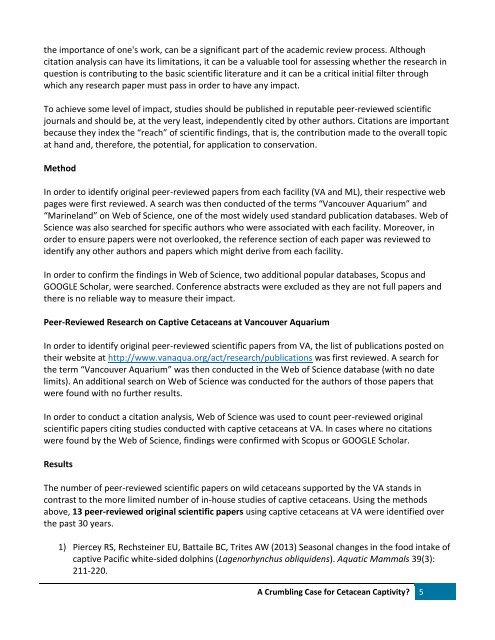A CRUMBLING CASE FOR CETACEAN CAPTIVITY?
MM-Education-and-Conservation-Report-Dec-9-2016-fi
MM-Education-and-Conservation-Report-Dec-9-2016-fi
You also want an ePaper? Increase the reach of your titles
YUMPU automatically turns print PDFs into web optimized ePapers that Google loves.
the importance of one's work, can be a significant part of the academic review process. Although<br />
citation analysis can have its limitations, it can be a valuable tool for assessing whether the research in<br />
question is contributing to the basic scientific literature and it can be a critical initial filter through<br />
which any research paper must pass in order to have any impact.<br />
To achieve some level of impact, studies should be published in reputable peer-reviewed scientific<br />
journals and should be, at the very least, independently cited by other authors. Citations are important<br />
because they index the “reach” of scientific findings, that is, the contribution made to the overall topic<br />
at hand and, therefore, the potential, for application to conservation.<br />
Method<br />
In order to identify original peer-reviewed papers from each facility (VA and ML), their respective web<br />
pages were first reviewed. A search was then conducted of the terms “Vancouver Aquarium” and<br />
“Marineland” on Web of Science, one of the most widely used standard publication databases. Web of<br />
Science was also searched for specific authors who were associated with each facility. Moreover, in<br />
order to ensure papers were not overlooked, the reference section of each paper was reviewed to<br />
identify any other authors and papers which might derive from each facility.<br />
In order to confirm the findings in Web of Science, two additional popular databases, Scopus and<br />
GOOGLE Scholar, were searched. Conference abstracts were excluded as they are not full papers and<br />
there is no reliable way to measure their impact.<br />
Peer-Reviewed Research on Captive Cetaceans at Vancouver Aquarium<br />
In order to identify original peer-reviewed scientific papers from VA, the list of publications posted on<br />
their website at http://www.vanaqua.org/act/research/publications was first reviewed. A search for<br />
the term “Vancouver Aquarium” was then conducted in the Web of Science database (with no date<br />
limits). An additional search on Web of Science was conducted for the authors of those papers that<br />
were found with no further results.<br />
In order to conduct a citation analysis, Web of Science was used to count peer-reviewed original<br />
scientific papers citing studies conducted with captive cetaceans at VA. In cases where no citations<br />
were found by the Web of Science, findings were confirmed with Scopus or GOOGLE Scholar.<br />
Results<br />
The number of peer-reviewed scientific papers on wild cetaceans supported by the VA stands in<br />
contrast to the more limited number of in-house studies of captive cetaceans. Using the methods<br />
above, 13 peer-reviewed original scientific papers using captive cetaceans at VA were identified over<br />
the past 30 years.<br />
1) Piercey RS, Rechsteiner EU, Battaile BC, Trites AW (2013) Seasonal changes in the food intake of<br />
captive Pacific white-sided dolphins (Lagenorhynchus obliquidens). Aquatic Mammals 39(3):<br />
211-220.<br />
A Crumbling Case for Cetacean Captivity? 5


